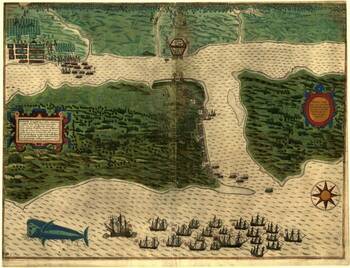From the Medieval Research Blog: "St. Augustine: Florida’s Medieval City"

Along oyster beds, sand dunes, and marshy coastal lowlands rise the church spires and walls of a medieval coastal city. This isn’t Northumbria’s Holy Island or Normandy’s Mont-St-Michel, though. This is the City of St. Augustine, Florida, the oldest city continuously occupied by Europeans and African-Americans in North America. This settlement on Florida’s First Coast predates the arrival of the Mayflower pilgrims at Plymouth in 1620 and even the 1607 founding of Jamestown, the first permanent English settlement.
The Age of Reconnaissance
St. Augustine was founded by the Spanish in 1565 as part of the fifteenth- and sixteenth-century European push to discover, explore, and settle new lands beyond Europe. This “Age of Reconnaissance” is one of the hallmarks for historians of the transition from the late Middle Ages into the Early Modern period in Europe.
Historian J. H. Parry describes the medieval beginnings of this push, especially in Spain:
“The initial steps in expansion were modest indeed: the rash seizure by a Portuguese force of a fortress in Morocco; the tentative extension of fishing and, a little later, trading, along the Atlantic coast of North Africa; the prosaic settlement by vine and sugar cultivators, by log-cutters and sheep-farmers, of certain islands in the eastern Atlantic. There was little, in these early- and mid-fifteenth-century ventures, to suggest world-wide expansion.”
In the later fifteenth-century, though, this expansion indeed exploded globally. The desire to expand wealth through acquisition of new lands, slave labor, and precious metals and stones, as well as the desire to convert any newly-discovered peoples to Catholicism, were powerful enticements for Spain to explore. Developments in nautical navigation, map-making, and ship technology made exploration possible.
Spain’s first encounter with the Florida coast came during the explorations of a medieval Spaniard, Juan Ponce de Léon (b. ca. 1460 in Léon, Spain). In early April 1513, with a license from Spain’s King Ferdinand II (1452–1516), Ponce de Léon sailed from Puerto Rico looking for Bimini (the Bahamas) and, legend has it, the Fountain of Youth. He found Florida instead, landing somewhere between St. Augustine and Melbourne Beach.
Claiming it for Spain, he gave the supposed island its Spanish name of La Florida, or Pascua Florida, depending on which source you look at; both names suggest Ponce de Léon was struck by the abundance of flowers he must have seen. (“Pascua Florida Day” is a state holiday and is celebrated on or around April 2nd each year.) He then sailed southward around the peninsula to explore further. Ponce de Léon returned to Spain and procured Spain’s consent to colonize the New World; thus Spanish settlement began.
This is an excerpt from "St. Augustine: Florida’s Medieval City (Part I)" written by Megan J. Hall (Ph.D '16). Read the full story (and check out Part II as well!)
Originally published by at medieval.nd.edu on September 19, 2022.
Latest Research
- ‘A special challenge’: German studies scholar wins National Humanities Center fellowship for research on medieval womenFor CJ Jones, the joy of research is not the answers but the journey. And the next step on that journey is a fellowship with the National Humanities Center. …
- Notre Dame Lead Innovation Team partners with local WIC program to identify, prevent lead poisoning in childrenB.A.B.E. store “shoppers” now have something new to help their families: free lead screening kits offered by the University of Notre Dame’s Lead Innovation Team.
- Notre Dame Welcomes Ninth Cohort of Warrior-Scholars for Transformative Academic JourneyNOTRE DAME, IN – The University of Notre Dame recently concluded its ninth successful Warrior-Scholar Project (WSP) boot camp, hosting 34 dedicated Warrior-Scholars from June 21st to 28th. This intensive, week-long academic residency provided transitioning service members and veterans…
- Entrepreneurship and Empowerment in South Africa study abroad program celebrates 25 yearsThis year, the Entrepreneurship and Empowerment in South Africa (EESA) program marked its 25th year of operation. EESA is a six-week summer study abroad program that enables students to help historically…
- Vatican honors Martin and Carmel Naughton with papal awardCarmel…
- Brain tumor growth patterns may help inform patient care managementAssistant Professor Meenal Datta (University of Notre Dame/Wes Evard) A team of researchers from the University of Notre Dame, Harvard Medical School/Massachusetts General Hospital, and Boston University has developed a technique for measuring a brain tumor’s mechanical force and a new model to estimate how much brain tissue a patient has lost.













